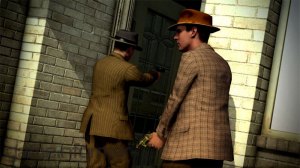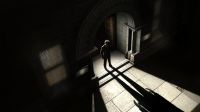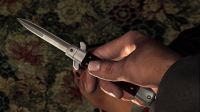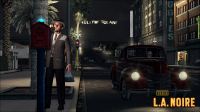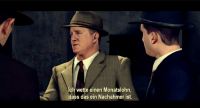NEWS Erster Trailer zu L.A. Noire von RockstarNach den Ausflügen in die Prärien, Wälder und Berge des Westernszenarios von Red Dead Redemption kommt nächstes Frühjahr ein erneuter Freeroam-Ausflug in die Vergangenheit. In L.A. Noire dürft ihr euch frei durch das Los Angeles der 1940er-Jahre bewegen und euch dabei unter allerhand Gangster und korrupte Cops mischen. Ihr schlüpft in die Rolle von Cole Phelps, einem aufstrebenden Beamten des LA Police Departements. Im Gegensatz zu GTA werdet ihr also eher des öfteren bereits ausgekühlte Opfer von Schiessereien untersuchen, als selbst die Berge zu verursachen. Angesichts der 22'000 Seiten Skript, welche für ungefähr zwei volle Staffeln einer TV-Serie oder 12 durchschnittliche Kinofilme reichen würde, darf man einen reichhaltigen und spannenden Detective-Thriller erwarten, der genügend Beinfreiheit für Nebenerkundungen lässt. Oder mit anderen Worten: L.A. Noire ist bereits der nächste Kandidat aus dem Hause Rockstar Games für höchste Ehren und Lobpreisungen. Der erste Trailer mit Gameplay-Elementen: Die Kollegen von Eurogamer haben ein ausführliches Preview bereit » Ein ausführliches Preview mit Bildern in Englisch gibts hier » Wer sich den Sprung sparen möchten, hier die Transkription: L.A. Noire PreviewA car sits deserted in a dusty lot. One door hangs open. The driver’s seat and windscreen are bathed in gore- certainly way more blood then anyone could safely lose. A pipe lies nearby in the dirt, and elsewhere a pair of broken Spectacles. A receipt in the car’s trunk begs the question; who’s A Hogan, and why did he pick up a living pig yesterday? Deduction is the core of LA Noire, an open-world detective game steeped in the fiction of Dashiell Hammett and James Ellroy, informed by the police records, newspapers and maps of the 40′s Los Angeles. Evidence is gathered and examined, witnesses interrogated, suspects shaken down. Though published by Rockstar and taking place in a open city ( a near street for street recreation of LA Circa 1947) those expecting GTA to turn up in a fedora have been following a bad lead. As Cole Phelps, a cop working his way up through the LAPD, you’ll spend considerably more time thinking about the case before you, and the constellation of facts that compromises it, than you will mowing down band guys. The distinction is most obviously drawn by the fact that you are now on the other side of the law, but more profoundly because LA Noire follows a different rhythm to open-world action titles like GTA, a meditative pace in which detection rather than destruction in the propellent. There maybe be bodies aplenty, but most of the cadavers in question have cooled well before you encounter them, framed by chalk outlines. Back at the parking lot, with it’s bloody abandoned car and missing pig, there is a distinct lack of chalk outlines. The absence of an actual body means the case fails to Phelps, currently working the traffic desk. As the game progresses, Phelps moves up from regular beat officer to dealing with traffic offences, and then trough robbery,vice and homicide, tussling with new partners each time. The late 40′s is a tumultuous period for the LAPD, and Phelps, a man of moral standing and ambition, finds himself embroiled in the tussle between bent cops and the anti corruption witch-hunts that seek to straighten out the force. Australian development studio Team Bondi is tight lipped about how this larger narrative thread unravels, save for the fact that it is structured like a TV serial — each episode enclosing a single chase, while feeding in to the grand sweep of the overall story. This particular episode has the name “The driver’s Seat†— words which splash across the screen in italics, like the title of an old cop show. But it’s deference to genre doesn’t, from what we’ve seen, lead it into simply regurgitating Bogart-flavoured clichés. Nor does it feel like you are being presented with a prescribed puzzle — perhaps because the case in question, like many of those in the game, is drawn from real police records and newspaper reports of the time. Though Team Bondi has Massaged the nebulous detail of these crimes into clearer lines of inquiry, and the occasionally conceived solutions to cases that were never actually solved, there is a fidelity to the complex situations and the subtleties of detection. Its element of sleuthing may owe as to Phoenis Wright as its vast urbanity does to GTA, but that sense of freedom familiar to open worlds is imported to the process of investigation differentiating LA Noire from point-and click mysteries. Depending on who you talk to, how much evidence you turn up and what you are able to deduce from these, cases might take any number of directions, or indeed fail altogether. “With traditional adventure games, everything is based on what the designer wants you to figure out†Says Jeronimo Barrera, vice president of product development at Rockstar. “We’ve kind of gone for a different approach which is more like real-world detective work†“You don’t have to find an anchor and combine it with a grapefruit†adds Brendan Mcnamara, co-founder of Team Bondi and the primary create force behind the game. “Everyone knows cop shows — I think that keeps it reasonably approachable. Players know if you turn up at a crime scene you usually have to go and talk to someone and look at the clues around a dead body. Even if the game isn’t that familiar to them, that format is. Nonetheless, the crime scene investigation is almost overwhelming in its possibilities, with myriad details inviting scrutiny but needing to be carefully sorted for their relevance to the case. An officer at the scene is informs us that the abandoned car is registered to a Eugene White, reported missing the previous evening, and as we pace round the vehicle we find a wallet lying the dirt, yielding his name, address and picture, along with that of his wife. As Phelps pores over the scene his head automatically tracks to the items of interest; the player is able to pick up and articulate each one, the camera panning in as Phelps rotates a bloodied pipe to reveal the word ‘Instant-heat’. A pair of glasses throws up a brand name too, and Phelps observes that they’ve been broken and repaired — such commentary flags up possible clues, which are logged in your notebook. Tucked into the boot is a receipt for a pig, purchased by an A Hogan. The plot thickens. Armed with this handful of disparate details, we turn to our first witness, Earl Wilkie, the local rail worker who called in the abandoned vehicle. It’s little exaggeration to say that the rest of the game was conceived around the idea of interrogation, and it’s quickly apparently why. Wilkie’s face shifts between impatient and nervously deferential, eyes flicking, every part of it as alive and mobile as a real human face — and, vitally, just as readable. La Noire’s facial animation, it seems, has scaled the precipitous slopes of the uncanny valley, leaving the likes of Heavy Rain still scrabbling at the escarpment below. We open our questioning of Wilkie with a basic ice-breaker and he describes how he came across the car, his curiosity aroused by its odd positioning. He phoned the police when he saw the blood, he says. We can now refer to a list of possible conversation topics scribbled in our notepad. “Do you know a Eugene White, Mr Wilkie†We ask. “No,sir. That ain’t a name I’m familiar with,†Wilkie replies, shaking his head, putting adamantly, with a slight roll of the shoulders — movement that is natural and subtly confident. After these first opening shot, the interrogation turns into a game of verbal strategy, albeit one in which the mechanics are covered by a credible flow of conversation. A dial on the right of the screen indicates that we can choose to force, accuse or coax: stances which determine the broad direction of your retort, but, like Mass Effect, not its specific content. Barrera interjects: Do we believe Wilkie? We immediately second-guess ourselves- he seems perfectly convincing, but then maybe we’re just being credulous. La Noire’s faces are capable of such great subtlety that we worry we might be deceived. We needn’t over-think Wilkie’s response, however, as McNamara explains: “we get people to do poker body language, like tells. As much as we want it to be subtle and naturalistic as possible, we also want people who buy the game to be able to read it, so we really try and sell that people are lying — but it’s often not big enough for me. One of the actors will go: “I just told a massive lie†And I’ll ask if they can tell a bigger one. We conclude that, give the absence of overt shiftiness, Wilkie is telling it straight, and opt to ‘coax’ him. Consequently, we ask if he’d seen the car before. “As a matter of fact, I did†he says. “A couple of nights ago it was parked over there in the parking lot. I know most of the cars that park here regularly so it kind of stood out†Next we bring up the wallet, coyly asking if there was anything in it when he arrived. Wilkie is suitably indignant, chin jutting out as he says, “You accusing me of something, mister?†But he’s also wringing his hands. What could he be hiding?†“Everyone is lying about something,â€says McNamara. “When you talk to cops that’s what they say: You have to cut trough all the other bullshit before you get to the stuff about the case. When people talk to cops they naturally lie because they don’t want to get involved or whatever else — but what’s important to the case? If you accuse someone too often without evidence, they’re going to clam up on you.†Having weighed up the options, we decide to give Wilkie a taste of ‘Force.’ “Do you want the patrol man to hold you down while we turn out your pockets, MR Wilkie?†We ask with an aggressive swagger. Wilkie decides that he doesn’t like the sound of that. So, sure, he took a look in the wallet, but not because he intended to steal anything. There wasn’t any money in there, anyway- “Not even change†He’s emphatic and we can’t help but believe him, even if that means we’ve failed to squeeze a single lead out of the interrogation. Underpinning the astounding facial fidelity on the display is a motion capture technology called ‘Motion- Scan’. It’s been developed at the Sydney-Based depth Analysis, a company McNamara founded with the explicit purpose of powering LA Noire. The result, as he describes it, is a ‘Lying Simulator’. “This system allows subtle human emotion to come trough in a way which traditional animation doesn’t†Explains Oliver Bao, Depth Analysis head of research and development. “We can use this feature to get actors to lie, and players can detect that they’re trying to hide something. It’s like you’re talking to a real person — you can press their buttons and see how they react†Motion scan is different from most other capture and animation systems which either use markers or video video analysis to match gross facial movements to a pre-existing model, moving it by a form of puppetry. The process Depth Analysis favours is to continuously scan the entire shape of the actor’s head, simultaneously capturing it’s texture and colour, not to mention the words coming out of it’s mouth. “I’ve been doing mo-cap for 12 years, †Says Mcnamara. “I’ve been pleased with what we got out of it — but what I really wanted to do was to capture the outside of the people and not their bones. †The Depth Analysis solution uses 32 camera’s acting in pairs as range scanners, and a small, sound proofed white room, evenly lit to remove all the shadows. “It’s the same technique used by the Dam Busters†says Bao “They used tw eyes to work out what height they were from the water. It’s the same idea with our cameras — they’re all calibrated to they know where they are from each other, so when they see a feature point, they can estimate it’s depth.†The result is not so much an animation — indeed, animators are required to do little more than compose the moving model in a scene — but a 3D film of the actor, make up and all. There’s barely 20 minutes spent on processing each piece of raw footage before it goes straight into the game. “The way it works is that we have video editors working in the background as we record, so they can start editing straight away.†Bao explains as he shows us around the inauspicious warehouse that serves as Depth Analysis’ LA Studio. “They cut off the junk bits, top and tail, and whenever there’s downtime, like at lunch, they can show the takes to the directors so he can select the best. It’s very much like a factory†We peek inside the white capture booth, it’s array of glaring light panels and cameras making it look like the helm of a far-future spaceship. Michael McGrady from the cop drama Southland sits in the captain’s chair, patiently waiting for the final touches to his hair and make-up to be applied. “We have to watch out for the son the face,†Bao explains, gently prodding McGrady’s period-accurate bouffant. “Because we pick up colour and texture, we need to make it as a matt as possible so the camera’s don’t see hotspots. You’ve got the director’s camera at the front there, monitoring the character’s performance. The director next door can talk to the actor and can pop up trough the webcam on that monitor and show the script to him or reference videos.†Today, MCGrady, who plays one of the Phelps’ partners, is doing cutaways: reaction shots for use when other characters are talking. His hard-bitten police officer isn’t given to great displays of flamboyant emotion ( In the good cop-bad-cop routine he’s clearly the one cracking his knuckles) yet the fidelity of the capture process is such that McGrady is able to get away with the subtlest of facial movements to express hints of sadness or sympathy. McNamara leans into the microphone which allows him tom communicate with the capture room. “Stop thinking about food†he instructs McGrady who raises an eyebrow. “we do it line by line,†McNamara explains. “Sometimes they want the other part to read to them, then we do that. Mike is left in limbo and hast to listen to us for direction†He leans into the microphone again. “You have to listen for direction, don’t you, Mike? But you never take it.†“Well, I pretend I take it,†McGrady shoots back. Later, we talk to Aaron Station, who plays the protagonist Cole Phelps ( And also Ken Cosgrove in the TV series Mad Men) about the difference between this capture process and working on set. “I think the biggest adjustment is the lack of an acting partner — not having another person there in the space†he says. “But part of being an actor is using your imagination to create the possibility of what a space could be and see something that isn’t there. †“It’s weird trying to humanise that process †McNamara Agrees, “but the good part is that we’ve done all of it in mo-cap.†“Yeah, there’s is definitely a frame of reference,†Staton says. “Almost everything we’re doing in here we’ve already done as an ensemble [For Full body mo-cap] so as far as the timing of it and a general sense of what’s going on, there’s definitely a concrete frame of reference, but the trick is recalling that in a n authentic way. We explore a few different options, do a few different takes on each line. Brendan will have his work cut out for him piecing it together.†This is no exaggeration, but then it seems Team Bondi isn’t a studio to do things by halves. “The script’s up to 22,000 pages,†McNamara explains. “That’s two full years of a TV series and probably 12 Feature films. It goes a lot of places! While being able to tell if someone is lying was always central to the game, early designs saw the interrogations play out in somewhat less sophisticated way, as McNamara recalls: “Originally, we have it so that if you hit the people they gave you more information — it just became this slapothon. We tried all sorts of things with the conversations to make them into a game. We did loads of sophisticated AI to try and do natural language stuff but in the end people wanted to make choices themselves — it’s fundamental, we should have realised that quicker — and they wanted what they did to influence the outcome. That meant taking the story different places. Depending on what you ask, we have branches in the story. If you ask the right things you might get somewhere quicker, but if you get it wrong it might dead-end you and the story moves off somewhere else. You can play out the cases in different ways — some can play out in nine different ways.†The player isn’t alone as he navigates the twisted branches of the narrative, however. Get stuck and you can always speak to your partner, who’ll offer a suggestion as to what the next step should be. In the case of The Driver’s Seat, our partner is the irascible Bukowsky. He seems to resent Phelps’ rapid rise trough the force, but he’s helpful enough to suggest we go and talk to Eugene White’s wife, having exhausted the possibilities of the crime scene. The drive to the White Residence is uneventful, but it needn’t to be missing out on potentially useful dialogue with your partner, not to mention the many distractions LA Has to offer. There is, for a one thing, the staggering detail with which Team Bondi has recreated the city and it’s population, who come and go with the natural cycle of day and night. “I grew up in the post-Vietman generation,†McNamara says when we ask about this fascination with LA. “We were trying to get a sense of how a country could come out as the shinning knight of WWII and go on this constant slide trough Vietnam and all the rest. I think Hollywood is a good mirror for that, because it had this veneer: The American Dream which it sold to the world.†But you don’t need to dig far to find dirt. Certainly not in Team Bondi’s LA, anyway — as you drive about you are likely to hear calls fro assistance on as -yet-unassigned cases through the police radio, or spot robberies or car-jacking in progress. WE manage to resist such distractions en route to the Whites’ House, directed trough the sprawl of LA by our partner. While the game deigns to have a GTA-Style mini-map, an overlaid GPS route guide was presumably as step too far for the period dressing. Similarly, the game avoids Mafia’s stumbling block of rigorously recreating the unwieldy physics of 1940s vehicles — LA Noire’s cars might look the part, but they move with a bit more zip than their real-world counterparts ever did. Upon arrival, we find Mrs White in a state of distress. She last saw her husband as he left to go for a drink with a colleague called Arty Hogan — a name familiar to use from the receipt in the car’s boot. But, as we take a look around the house, Mrs White’s insinuation of a happy marriage seems dubious. They sleep in different bedrooms. In Eugene’s Room, close to inspection of a picture frame reveals a dedication from a unknown woman. More suspicious still is the fact that the pipe we found at the crime scene matches a part missing from a recently ordered boiler at the house. Could Eugene White’s assailant be closer to home? We ask Mrs White about the picture frame, but she claims there’s nothing to tell- it’s simply a photo taken during a recent business trip. The questions go back and forth; when you accuse someone, there’s usually some resistance and you have to resort to your notebook to supply the correct piece of evidence. When we accuse her of knowing more than she’s letting on, Mrs White doesn’t crumble until we point out the dedication written on the picture frame. Then it comes out: Eugene’s been having an affair, and his wife does not have an alibi for the previous evening. Nonetheless, she seems an unlikely killer - hardly of the build required to bludgeon someone into jam and lug the body elsewhere. More importantly, her quivering lip is convincing enough of her genuine concern and upset. We decide to pay pig-purchaser Arty Hogan a visit — using a nearby phone to call up the records and Identification department for the address of the bar where he was to meet Eugene. We find him in the back, the picture of guilt. He nonetheless evades the questions, until we pin the receipt to him. Finally he comes clean — and the truth is more farcical than sinister. Eugene hoped to cover up his elopement by faking his own death, persuading Hogan to help him kill a pig and splatter the car in it’s blood, while depositing a few personal possessions around the scene. After a few more threats of less-than-orthodox interrogation techniques, Hogan reveals that Eugene is holed up at his house; but if your line of questioning fails here, you can always follow Hogan back home and surprise the pair of them. While the pace of the game has been methodical so far, it’s evident that Team Bondi has worked out ways in which to add an action element to the climax of each case. Cas chases, fist fights or shoot-outs inject the adrenaline required to grab the attention of Rockstar’s existing action-fed audience. In this instance Eugene makes a run for it, diving out of a window and pelting across rooftops with you in pursuit. The chase comes to an end when your partner skids around a corner in his car and heads Eugene off — but there are other possible outcomes; Draw your gun and fugitives may reassess their chances and give themselves up. “We hope she was worth it, Eugene,†Phelps says as he slaps on the cuffs. “You want to do projects that get you out of bed†McNamara says. “Whether it can get you out of bed for five years straight is another story†That’s a long time. Even [L.a Noire's ] technology is a huge challenge: There’s a huge data side to that. The risk Rockstar took was buying in to my idea — that we could make a huge genre in movies and literature work in games when no one else had.†“For us it’s always good when you are crafting something and you don’t have a point of reference from other games†counters Barerra. “Even though you could say it’s like GTA because you have this open city you can run around in, it’s paced completely differently. To us that’s what we have to sell: “Look it’s not super-high action like GTA, though there is action, but it’s not as compelling because of the interactions the characters are having. †We wonder whether an audience trained by GTA and its wannabes to associate open worlds with mayhem will be able to settle into La Noire’s more sedate rhythm. It’s not yet clear what disincentives have been applied to stop the player ploughing through traffic and murdering the citizenry, but one thing it has in its favour is a powerful context, both in the careful drawing of setting and the characters in it. The difference between this and GTA Is that you play a guy who’s out there trying to do good “Staton says. “Everyone will initially want to punch a old ladies — I probably would — but people are then going to be interested in the story solving the cases. And seeing what other old ladies they can punch†“Hopefully we’ll make the audience take a few leaps†Agress McNamara. “That’s always scary but I think a lot of people will appreciate that stuff too. We’re never tying to dumb it down for people. I think you should assume your audience is pretty smart. There’s no doubt that LA Noire is ambitious, a technical marvel and a thrilling hybrid of genres. At such a scale it is fair to wonder whether it can sustain the qualities evident in oru demonstration — being subtle , smart, and solidly produced — but if any company can oversee the radical evolution of the open world from chaotic sandbox to sprawling urban drama then it is surely Rockstar. Even without that reassuring name, Team Bondi’s evident ability to create human intrigue in this immense and painstakingly rendered vision of LA is already something that demands meticulous investigation.
Du kannst DN, den Autor dieses Beitrags, über seine Kontakt-Seite erreichen.
Das könnte dich auch interessieren:Erhältlich für PlayStation 3, Xbox 360 Von Rockstar Games (Publisher), Team Bondi (Developer) TESTBERICHTE Die schärfsten Kopfhörer der WeltGran Turismo 7 (PS4)Google Stadia: Ein holistisches Review (Android, PC)Playerunknown's Battlegrounds PUBG (PC, Xbox One)[Updated] Destiny 2 (PS4, PC, Xbox One)Metroid: Samus Returns (3DS)Mario + Rabbids: Kingdom Battle (Switch)Thimbleweed Park (Mac, PC, Xbox One)Nintendo Switch: Das Review (Switch)Horizon — Zero Dawn (PS4) MEINUNGEN Das Problem mit Destiny 2 (PS4, PC, Xbox One)Weshalb wir Forza 7 nicht reviewen (PC, Xbox One)PS4 VR-Games, nach Übelkeitsfaktor bewertet (PS4)Shenmue 3 und unrealistische Kickstarter-Budgets (DC, PS4, PC)Couch-Gaming: Was spielen, wenn Freunde zu Besuch sind? (Mac, PS3, PS4, Wii U, PC, Xbox 360, Xbox One)Ein Plädoyer für Batterien (PS3, PS4, Wii, Wii U, Xbox 360, Xbox One)Super Smash Bros bald auf 3DS, Wii UNintendo bringt 3DS mit zweitem Analog-Stick (3DS, Wii U)Windows-Spiele auf dem Mac mit Steam Streaming (Mac, PC)Neue Studie zu Gewalt und Videogames |




